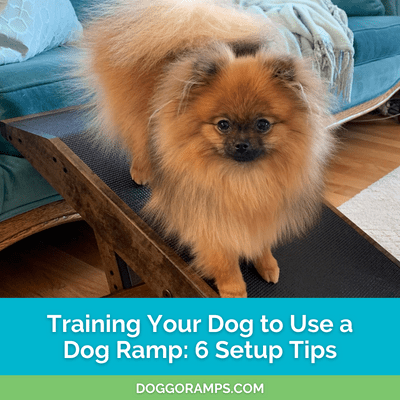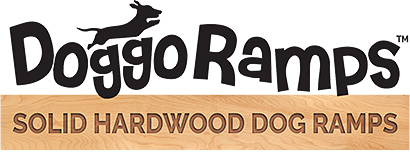Training Your Dog to Use a Dog Ramp: 6 Setup Tips

Taking the time to train your dog how to use a dog ramp can make a big difference with ramp use.
Proper training can help your dog learn how to safely and consistently use their ramp. This will allow your dog's ramp to play a bigger role with protecting their back and joints from jumping-related injuries and give you peace of mind as well.
To help you with training your dog, we’ve:
- developed a step-by-step ramp training guide
- created video demonstrations
- and published a supplementary post sharing solutions to common ramp training hurdles
We want nothing more than to hear that your pup is enjoying their ramp!
However, beyond our training exercises, there’s one more key factor that can influence ramp use and that's ramp setup or orientation.
So to support your dog with becoming a Ramp Champ, here are 6 essential dog ramp setup tips that can encourage your dog to consistently use their ramp.
1. Make Sure There’s Enough Space for Your Dog Ramp AND Extra Space Around It
Checking the dimensions of a dog ramp and confirming that it will work with your space is a must when choosing a ramp for your pup. At the same time, it’s also important to consider the amount of room that will be available around it - especially at the bottom of the ramp - as your pup should have easy and unobstructed access to it.
Overall, dogs like to choose the path of least resistance in order to get to wherever they want to go. If they feel like they have to squeeze themselves into a tight corner or space to reach the bottom of their ramp, they may not be as likely to use it.
TIP: To help you pick out the right ramp for your dog and space, all DoggoRamps dimensions are listed on every product page.
Fortunately, DoggoRamps couch and bed ramps have been intentionally designed to accommodate a variety of orientations. This means that it’s possible to set up 1 ramp in a few different ways to make it a better fit for your pup and room layout. Just take a look at the illustrations below:

The DoggoRamps Couch Ramp can be centered, placed to the side, or either parallel or perpendicular to the couch.

DoggoRamps Bed Ramps can be set up along the foot of the bed or side of the bed. You can have it extend out past the foot of the bed to allow space for a person to enter from that side of the bed as well.
2. Consider Your Dog’s Range of Motion and Place Their Ramp Accordingly
As you can see, there are a variety of ways you can set up your pup’s DoggoRamp so that they can reach the couch or bed. When deciding which orientation may work best for your dog and space, it’s also helpful to think about your dog’s range of motion.
Senior dogs, dogs with arthritis, and even long-bodied dogs, such as Dachshunds, Basset Hounds, and Corgis, may have a more challenging time manoeuvring their bodies. Reducing the amount of turns they may have to make to get on and off their dog ramp may make it easier for them to use their ramp and improve ramp use.

By having her ramp sloped down towards the entrance of the bedroom, @stellahfx, the 3-legged dog, doesn't need to take any unnecessary turns and can easily walk straight up to the bed.
On the other hand, smaller, fairly active dogs tend to have an easier time navigating turns:

3. Try Placing Your Dog’s Ramp Along Their Most Common Route
Dogs are creatures of habit. They enjoy structure and routine. If you observe your dog’s behavior around your home for even just a couple of days, you’ll start noticing that your pup most likely has preferred hangout spots and specific paths for reaching them. Placing your dog’s ramp along their existing route on and off the couch or bed can make a big difference with consistent ramp use.
If your dog hasn’t previously had access to the couch or bed, you can place their ramp where you anticipate their most frequent path on and off would be (typically the most direct path to the room's entrance/exit).
Customer Success Story: Tosh the Yorkie
When Tosh’s paw-rents first introduced him to his StepRamp, they placed it along the side of the bed that was closest to the bedroom door. They figured that the shortest route to the bed would be the best and most convenient route for their pup.
Tosh was already well-acquainted with using his DoggoRamps Couch Ramp, so he had no problem going up and down his StepRamp when prompted. However, when left to his own devices, he would avoid it.
Over the next few days, the Yorkie’s owners decided to see if there were any particular spots Tosh was already walking to in order to get on and off the bed. They soon noticed that Tosh would frequently walk all the way across the bedroom, around the bed, and hop on from the spot that was furthest from the door.
Even though it first felt counterintuitive - as it was so far from the door, Tosh’s paw-rents decided to try placing his StepRamp in that exact spot. Within minutes, Tosh was independently using his StepRamp and has been doing so ever since!

4. Find The Right Height Setting
All DoggoRamps couch and bed ramps have adjustable height settings so that they can work with virtually any hangout spot. They also feature a low-incline design to give dogs an easier time up and down. However, as to be expected, when a higher height setting is chosen, the incline of the ramp will become a bit steeper.
If you notice that your dog prefers a lower height setting with a gentler incline, it’s helpful to keep in mind that your dog’s ramp does not need to be set flush to the top of your couch or bed.
It’s perfectly natural for the top of your dog’s ramp to be a set a couple of inches lower so that your dog can take one small step up or down from their hangout spot. In fact, many medium-sized and larger breeds prefer this setup!

5. Don’t Hesitate To Experiment with Different Orientations
The placement of your dog’s ramp doesn’t have to be set in stone. Like with Tosh the Yorkie, experimenting with different orientations can help you discover which setup encourages the best and most consistent use from your dog.
Just remember that repetition helps build habit and routine. Instead of trying out a few different orientations in a single day, try leaving one in place for a few days or even a week to see which particular set up is truly a good fit for your pup and encourages best use.
6. Choose A Spot That’s Convenient For You Too
Last but not least, it’s also important to choose a spot for your dog’s ramp that doesn’t get in your way. When a ramp’s placement is convenient for you in addition to your pup, you’re more likely to leave your pup’s ramp out and in the same spot. This will give your pup the opportunity to keep using their dog ramp as part of their daily routine!

Mika's Couch Ramp orientation leaves plenty of space for her paw-rents to enjoy the sofa as well!
DoggoRamps training resources and setup tips have been followed by thousands of pet owners worldwide. They’ve successfully helped dogs of all ages, sizes, and temperaments become Ramp Champs!
We know that with the right ramp, training process, and setup, all dogs are capable of using their ramp!
To learn more about which indoor dog ramp would be the best fit for your pup, check out:
- The DoggoRamps Couch Ramp for All Dogs (supports up to 150lbs.)
- The DoggoRamps Small Bed Ramp for Small and Toy Breeds (supports up to 50lbs.)
- The DoggoRamps Large Bed Ramp for Medium and Large Dogs (supports up to 200lbs)
- The DoggoRamps StepRamp (supports up to 200lbs and a great fit for pups who could benefit from a little help to their favorite hangout spots but don’t yet need a full-fledged ramp)
And if you’re looking for customized training help, we’re always happy to provide personalized support for your dog and specific scenario! Just send us an email at doggoramps@gmail.com!
Happy Ramping!
Leave a comment
Comments will be approved before showing up.




